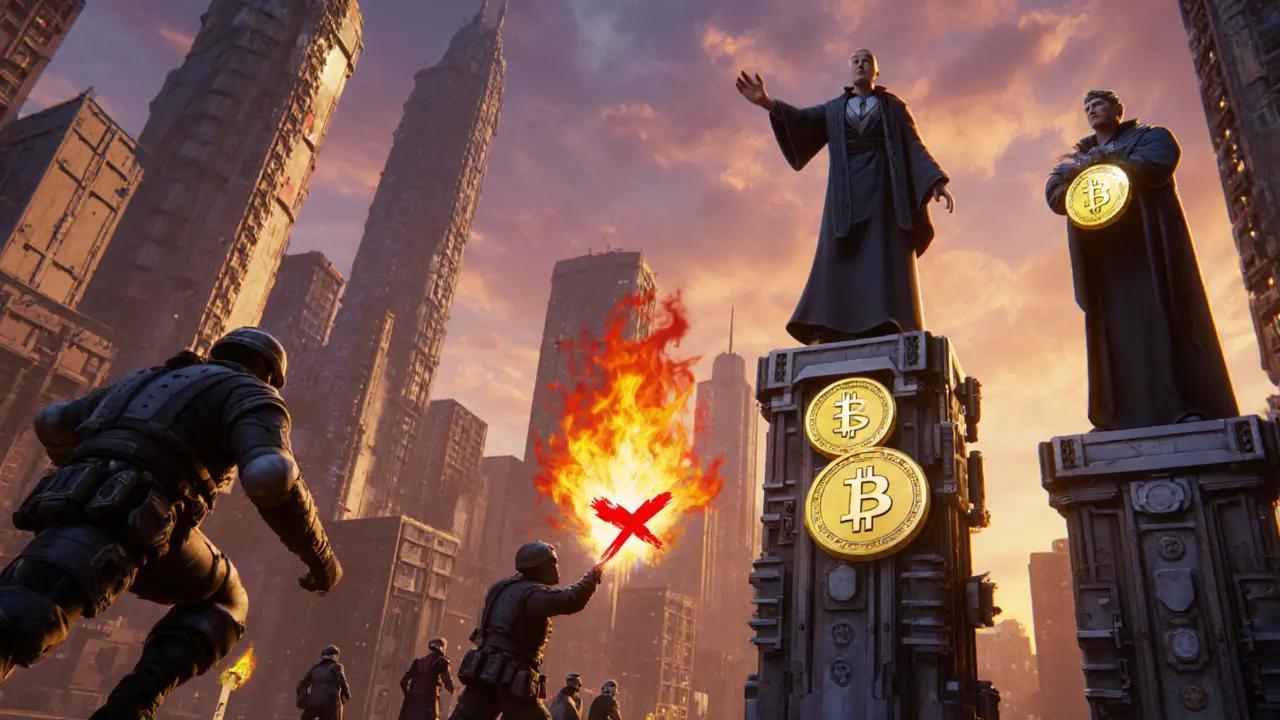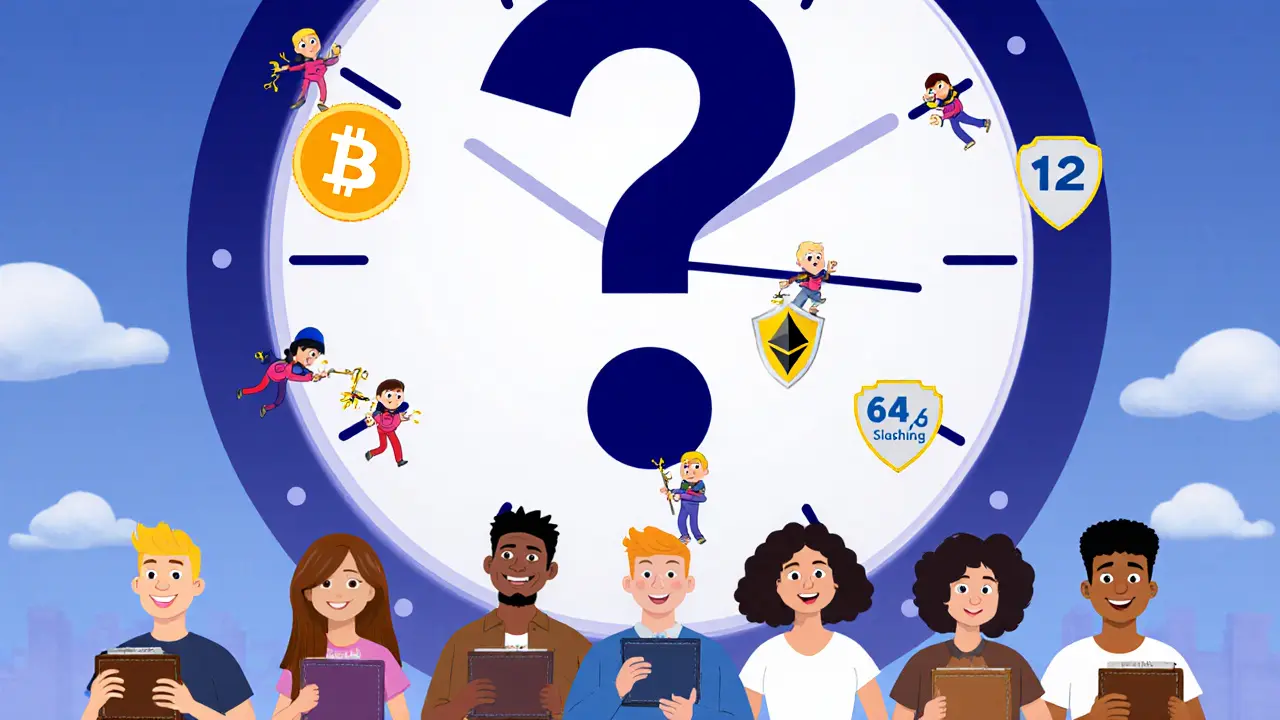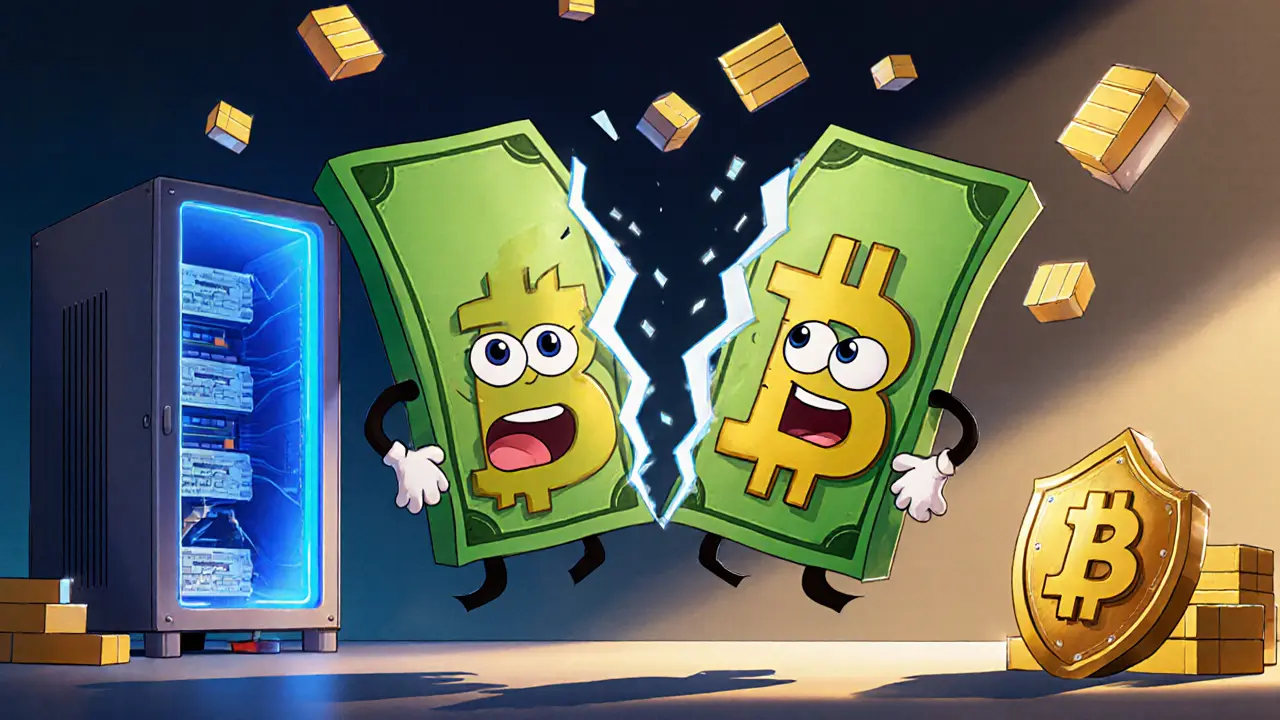Imagine sending $100 in digital cash to a friend, only to realize moments later that the same $100 was also sent to someone else. That’s double-spending - and it’s the biggest problem digital money had to solve before it could work at all. Unlike physical cash, where handing over a bill means you no longer have it, digital files can be copied. Without a way to stop this, blockchain-based money would collapse before it even started. But it didn’t. Here’s how different blockchains stop double-spending - and why some are safer than others.
Proof of Work: Bitcoin’s Bulletproof Shield
Bitcoin’s solution to double-spending is simple in concept but brutal in execution: make cheating astronomically expensive. Every transaction gets bundled into a block. Miners compete to solve a cryptographic puzzle - a math problem that requires massive computing power. The first to solve it gets to add the block to the chain and earns new Bitcoin as a reward.
Here’s the catch: if you want to double-spend, you’d need to not only create a fake transaction but also rewrite the entire history of the blockchain from that point forward. That means outpacing every other miner on the network. As of mid-2024, Bitcoin’s network runs at over 300 exahashes per second. To pull off a 51% attack - the only way to reverse transactions - you’d need to control more than half of that computing power. The cost? Around $14.5 billion in hardware and over $4 million per hour in electricity. No one’s done it. Not once.
Bitcoin’s security isn’t magic. It’s economics. The reward for honest mining far outweighs the potential gain from cheating. And with over 700 million confirmed transactions since 2009, Bitcoin’s track record speaks for itself. Most merchants wait for six confirmations - about an hour - before considering a payment final. That’s not because the system is slow. It’s because they’re being careful. One user on BitcoinTalk lost $32,000 after accepting a payment with just one confirmation. It got reversed during a rare chain reorganization. Don’t make the same mistake.
Proof of Stake: Ethereum’s Economic Lock
Ethereum switched from Proof of Work to Proof of Stake in 2022. No more energy-hungry mining rigs. Instead, validators lock up 32 ETH (about $102,400 as of 2025) to participate. They’re randomly chosen to propose and verify blocks. If they act honestly, they earn rewards. If they try to cheat - like approving two conflicting transactions - they get slashed. That means their entire stake is wiped out.
This shifts security from brute force to financial risk. To double-spend on Ethereum, you’d need to control two-thirds of all staked ETH. That’s not just expensive - it’s self-defeating. If you control that much, you’re already one of the most powerful players in the network. Destroying your own stake to pull off a fraud makes no sense. Plus, Ethereum’s finality mechanism ensures that once a block is confirmed across 64 epochs (about 15 minutes), it’s irreversible.
But there’s a trade-off. The top 10 staking providers control over 32% of Ethereum’s total stake. That’s not centralized control, but it does mean a small group holds disproportionate influence. And unlike Bitcoin, where miners are anonymous and globally distributed, Ethereum validators are often tied to companies like Coinbase, Kraken, or Lido. If those entities colluded - theoretically - they could manipulate the chain. So far, they haven’t. But the risk exists.

Delegated Proof of Stake: Speed Over Security
Some blockchains, like EOS and TRON, take a different route. They use Delegated Proof of Stake (DPoS). Instead of thousands of validators, only 21 to 27 block producers are elected by token holders. These elected nodes handle all transaction validation. It’s faster - TRON can process 2,000 transactions per second - but it’s also more centralized.
Double-spending here isn’t about computing power or staked assets. It’s about collusion. If five of the top 27 producers agree to lie about a transaction, they could approve a fake double-spend. There’s no slashing mechanism to punish them - just the threat of being voted out. But voting requires active participation. Most users don’t bother. That leaves power in the hands of a few.
StartupDefense.io warned in 2024 that DPoS networks are vulnerable to "coordinated attacks" if validator groups form cartels. That’s why DPoS works best for applications where speed matters more than absolute security - like in-game purchases or microtransactions. It’s not ideal for storing life savings. If you’re using a DPoS chain for anything valuable, always wait for multiple confirmations. Don’t assume it’s safe just because it’s fast.
Finality: What "Confirmed" Really Means
Not all blockchains define "confirmed" the same way. Bitcoin says six blocks. Ethereum says 64 epochs. Ripple does it in under five seconds. And some private chains - like those used by banks - use Practical Byzantine Fault Tolerance (PBFT), which can finalize transactions in seconds with just a few trusted nodes.
Here’s what you need to know: confirmation count is your safety net. A transaction isn’t final until enough blocks are built on top of it. The more blocks, the harder it is to reverse. Most exchanges and wallets treat 12 confirmations as "safe," even on Ethereum. Why? Because developers still get confused. On Ethereum Stack Exchange, a top validator once wrote: "Many DeFi protocols think 15 blocks are final. They’re not. It’s 64 epochs."
Chainalysis found that between 2020 and 2023, 12 exchange hacks happened because platforms accepted payments with too few confirmations. Total losses? Over $28 million. That’s not a flaw in the blockchain. That’s a flaw in how people use it.

What’s Next? Hybrid Consensus and Quantum Threats
The future of double-spending prevention isn’t just one mechanism. It’s blending them. Projects like Decred combine PoW and PoS: miners validate blocks, but stakeholders vote on changes. MIT’s Digital Currency Initiative found this hybrid model resists double-spending simulations 47% better than either system alone.
And then there’s quantum computing. In 10 to 15 years, quantum machines could break the cryptographic signatures that secure Bitcoin and Ethereum. The National Institute of Standards and Technology (NIST) is already funding $8.2 million in research to build quantum-resistant blockchain protocols. By 2027, Forrester predicts 65% of major blockchains will use hybrid consensus models to balance speed, security, and sustainability.
Regulators are catching up, too. The EU’s MiCA regulation, effective December 2024, requires all crypto service providers to prove their consensus mechanism prevents double-spending. No more vague claims. You need to show your math.
Which One Should You Trust?
It depends on what you’re doing.
- For storing value: Bitcoin’s PoW is still the gold standard. It’s slow, expensive to run, but has never been hacked.
- For smart contracts and DeFi: Ethereum’s PoS offers a good balance of security, efficiency, and developer tools.
- For fast, low-cost payments: DPoS chains like TRON or EOS work - but only for small amounts. Don’t send your rent money.
- For enterprise use: Private chains with PBFT are common. They’re fast and controlled, but not decentralized. Don’t confuse them with public blockchains.
There’s no perfect system. But there are clear trade-offs. Choose based on your risk tolerance. If you’re handling large sums, wait for more confirmations. If you’re building something, understand the consensus model before you deploy. And never assume a blockchain is "instantly secure." It’s not magic. It’s math. And math only works if you use it right.
Can you really double-spend Bitcoin?
Technically, yes - but only if you control over half of Bitcoin’s entire mining power. That would cost more than $14 billion in hardware and millions per hour in electricity. No one has ever done it successfully on the main Bitcoin chain. The economic cost makes it irrational. For any transaction over $1 million, the risk of a 51% attack is lower than the risk of a bank heist.
Why does Ethereum need 64 epochs for finality?
Ethereum’s PoS system doesn’t finalize blocks one by one. Instead, it groups them into "epochs" - 32 blocks each. Finality requires 64 epochs (2,048 blocks) to be confirmed by two-thirds of validators. This layered approach prevents "nothing-at-stake" attacks, where validators could support multiple competing chains. Waiting for 64 epochs ensures that even if some validators go rogue, the network can still detect and reject the fraud.
Is DPoS safe for large transactions?
No. DPoS networks like TRON and EOS rely on a small group of elected validators. If five or more collude, they can approve a double-spend. There’s no slashing penalty - just the possibility of being voted out. But most users don’t vote. That means a small, unaccountable group holds control. Use DPoS for small payments or in-app purchases, not for transferring thousands or millions.
How many confirmations should I wait for?
For Bitcoin: wait for 6 confirmations (about 60 minutes). For Ethereum: wait for 64 epochs (15-20 minutes). For high-value transactions - over $10,000 - wait longer. Many exchanges require 12-30 confirmations. Never accept a transaction with only 1 confirmation unless you’re okay with losing the money. That’s how most hacks happen.
Are there any blockchains that can’t be double-spent?
No blockchain is 100% immune. But Bitcoin and Ethereum come close under normal conditions. Their security comes from scale: Bitcoin’s massive computing power and Ethereum’s massive staked value make attacks economically impossible. Smaller chains - especially those with low hash rates or staked amounts - are vulnerable. Always check the network’s security metrics before trusting it with your funds.
What’s the biggest mistake people make with double-spending?
Assuming a transaction is final after one confirmation. Many new users think "confirmed" means "done." It doesn’t. It just means it’s in a block. Until enough blocks are added on top, it can still be reversed. This mistake has cost users and exchanges over $28 million in the last four years. Always check the confirmation count - and wait longer than you think you need to.

Suhail Kashmiri
November 12, 2025 AT 03:59Wow, so you're telling me we're trusting math instead of banks? And it works? I mean, I get it, but still... people are gonna keep getting scammed because they think 'confirmed' means 'done.' That's not blockchain's fault, it's human laziness.
Arthur Coddington
November 13, 2025 AT 09:03Let me get this straight-Bitcoin’s security is based on the fact that it’s too expensive to cheat? So we’re relying on capitalism to prevent crime? That’s not a system, that’s a gamble with electricity bills. And now we’re supposed to trust Ethereum because people put money in a lockbox? What happens when the lockbox owner gets bored and walks away?
Michelle Elizabeth
November 14, 2025 AT 17:24It’s funny how we treat blockchains like gods-‘Bitcoin never got hacked!’-but forget that every system has a weak point. The real vulnerability isn’t the code. It’s the people who think they’re safe because they saw ‘6 confirmations’ and didn’t bother to read the fine print. We’re not building trust in tech. We’re building trust in our own ignorance.
Joy Whitenburg
November 15, 2025 AT 17:32Y’all are overthinking this. I use TRON to buy my coffee and it works fine. If someone tries to double-spend my latte, I’ll just yell at them. Problem solved. 😅
Kylie Stavinoha
November 17, 2025 AT 06:50There’s a deeper philosophical question here: if security is measured in dollars and computational power, does that mean value is determined by who can spend the most? Bitcoin’s brilliance isn’t its cryptography-it’s its ability to turn economic incentive into moral behavior. We didn’t solve double-spending. We made cheating irrational. That’s not engineering. That’s sociology with a hash function.
Raymond Day
November 18, 2025 AT 07:21Let’s be real-Ethereum’s validators are just Wall Street in hoodies. Coinbase, Kraken, Lido-they’re not ‘decentralized.’ They’re oligarchs with servers. And don’t even get me started on how the U.S. government could pressure them overnight. This isn’t freedom. It’s corporate feudalism with a blockchain logo. The ‘economic security’ is a fairy tale for people who don’t read the whitepaper.
Atheeth Akash
November 19, 2025 AT 16:38Interesting read. I think DPoS is fine for small payments, but I agree-don’t use it for rent. I use TRON for tipping content creators, nothing more. Safety first, speed second. Also, thank you for mentioning confirmation counts. Many beginners don’t know this.
James Ragin
November 19, 2025 AT 19:29Wait. So you’re telling me the U.S. government hasn’t tried to attack Bitcoin? That’s impossible. The NSA has quantum computers. They’re just waiting for the right moment-when the price spikes-to trigger a 51% attack and collapse the system so they can seize all the coins. The $14 billion cost? That’s the cover story. The real cost is political. They’re biding their time. And you? You’re still waiting for six confirmations. Pathetic.
Kristin LeGard
November 21, 2025 AT 01:52So let me get this straight-you’re praising Bitcoin because it’s expensive to hack? That’s not security, that’s waste. We’re burning enough electricity to power a small country just to send a dollar. And you call that progress? Meanwhile, real innovation is happening in places that don’t need a power plant to verify a transaction. America’s obsession with brute force is why we’re falling behind.
Stephanie Platis
November 22, 2025 AT 12:07Let’s be precise: Ethereum’s finality is not ‘15–20 minutes.’ It is precisely 64 epochs, each consisting of 32 slots, each slot lasting 12 seconds-resulting in 24,576 seconds, or exactly 6 hours and 49 minutes and 36 seconds. Anyone who says ‘15–20 minutes’ is either misinformed or deliberately misleading. And yes, I checked the Ethereum consensus specification-twice.
tom west
November 23, 2025 AT 03:36The entire premise of blockchain security is a fallacy rooted in naive economic assumptions. You assume rational actors, but history proves humans are irrational, especially when money is involved. The 51% attack on Bitcoin is theoretically impossible-until someone with state-level resources decides to destabilize global finance for geopolitical gain. The $14.5 billion cost? That’s a red herring. The real cost is societal collapse. You think the U.S. Treasury would let Bitcoin survive if it threatened the dollar’s hegemony? They’ve already started planning countermeasures. The ‘trustless’ system is the most trusted system on earth-because everyone assumes it’s unbreakable. That’s the real vulnerability.
And don’t get me started on PoS. Validators aren’t ‘staked’-they’re coerced. The 32 ETH requirement excludes ordinary people. The system is designed for institutional capital, not decentralization. What you call ‘economic security’ is just oligarchic control dressed in crypto jargon. The fact that you’re praising this as innovation reveals your ignorance of power dynamics. This isn’t a revolution. It’s a rebranding of banking-with worse transparency.
And yet, you still wait for six confirmations? That’s not caution. That’s surrender. If you truly believed in the system, you’d accept one confirmation. But you don’t. You’re still trusting the same old institutions-you just gave them a new name: ‘the chain.’
The real question isn’t how to prevent double-spending. It’s why we still think we need permission to own money at all.
Phil Bradley
November 24, 2025 AT 11:30Okay, but what if I just... don’t care? Like, I send $10 to my buddy for pizza, he sends it back, we laugh, and life goes on. Do I really need 64 epochs? Or am I just part of the problem, over-engineering everything because we’ve forgotten how to trust each other? Maybe the real problem isn’t double-spending-it’s that we’ve turned every interaction into a risk assessment.
Noriko Yashiro
November 26, 2025 AT 07:57Love this breakdown! Honestly, I used to think PoW was the only way-but after seeing how Ethereum handles finality, I’m sold. Still, I agree with the guy who said ‘don’t trust speed over safety.’ I use a DPoS chain for my NFT art drops-because I need speed-but I keep my real crypto in Bitcoin. Smart moves, people!
Phil Bradley
November 26, 2025 AT 20:29Wait, so you’re saying if I’m sending $5 for coffee, I should wait 20 minutes? That’s insane. If someone double-spends my latte, I’ll just buy another. Life’s too short to be paranoid about microtransactions. The system’s not broken-it’s just being used wrong. Chill out. Have a coffee. And stop treating blockchain like a nuclear launch code.